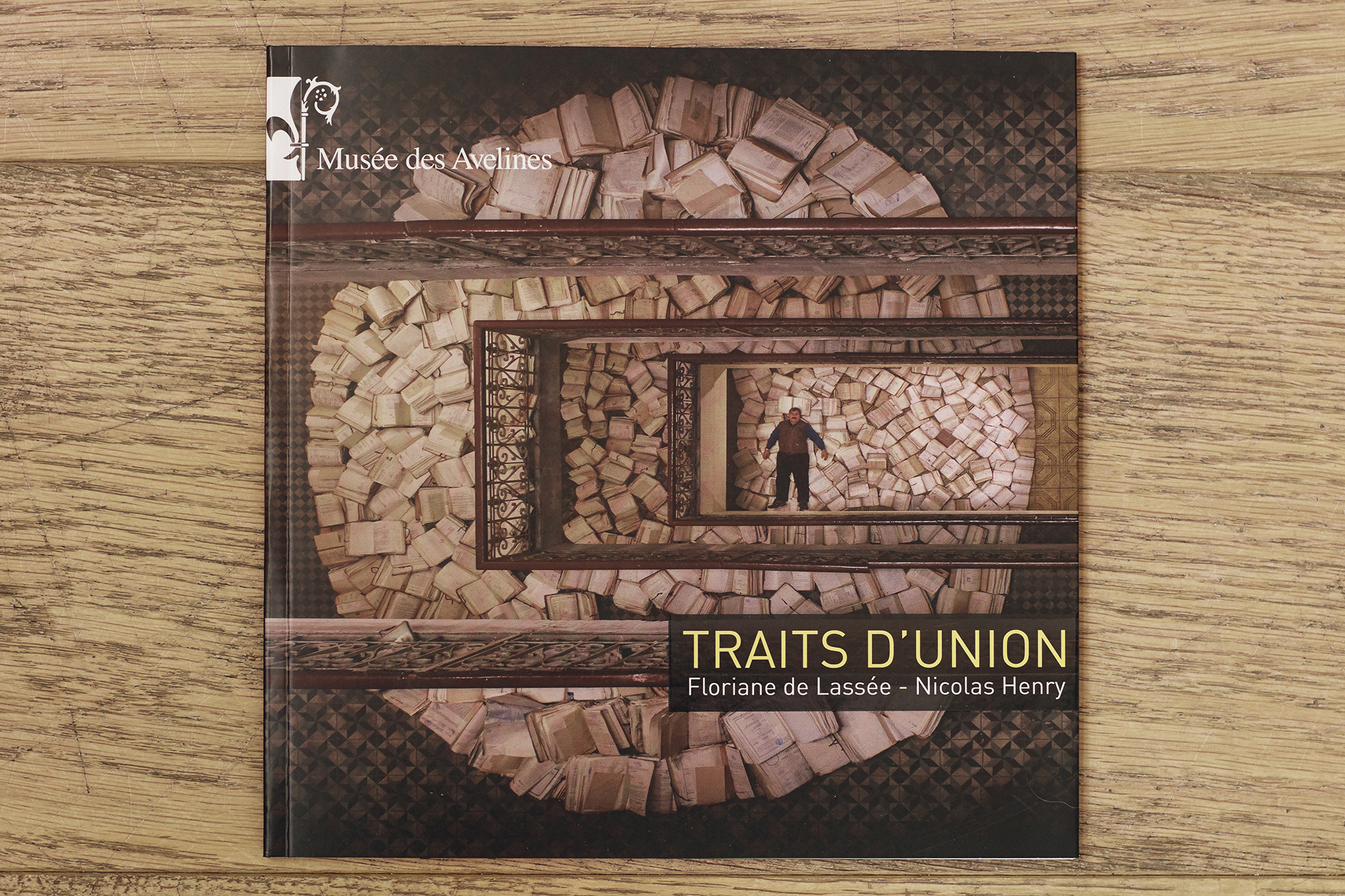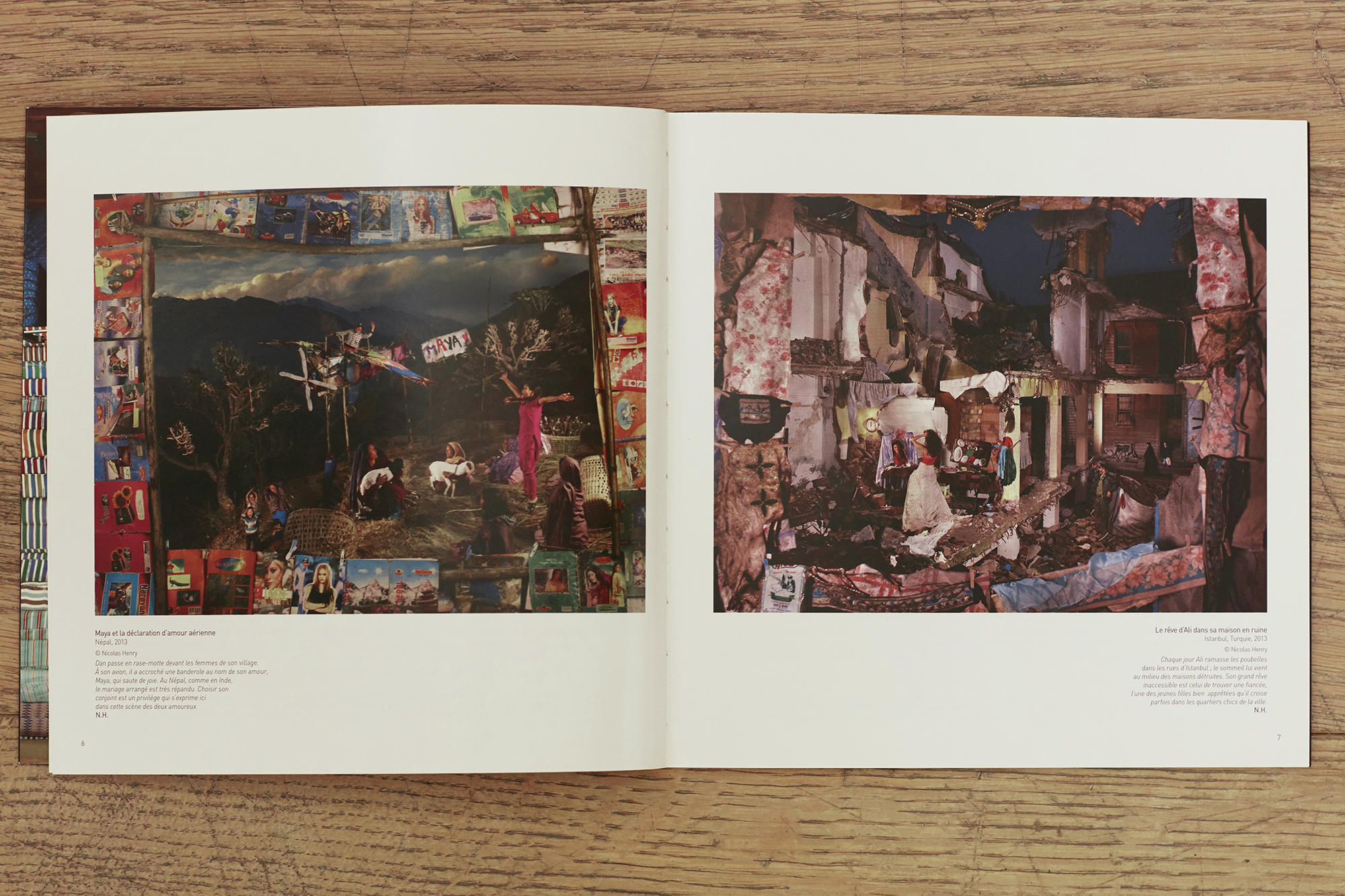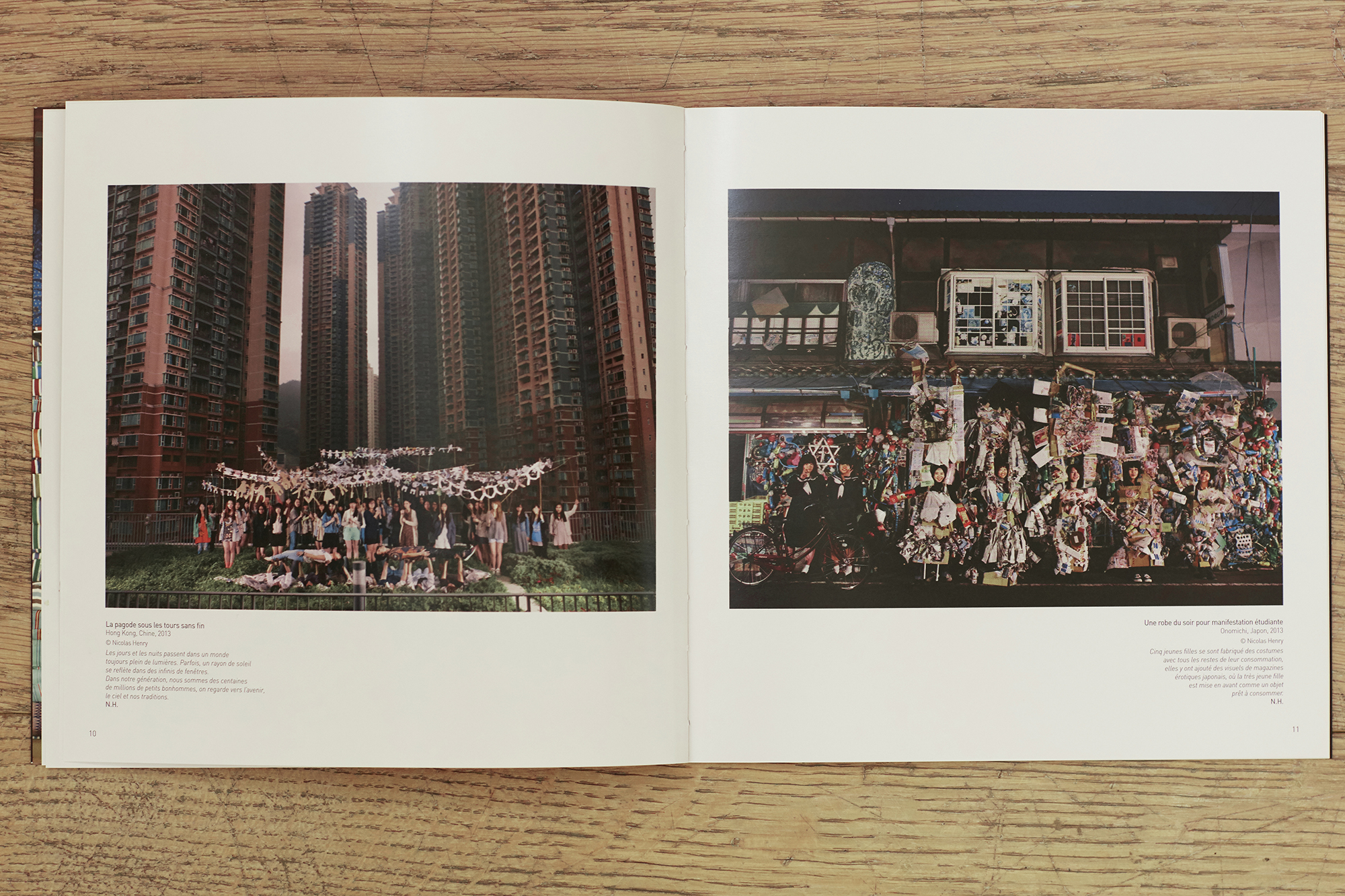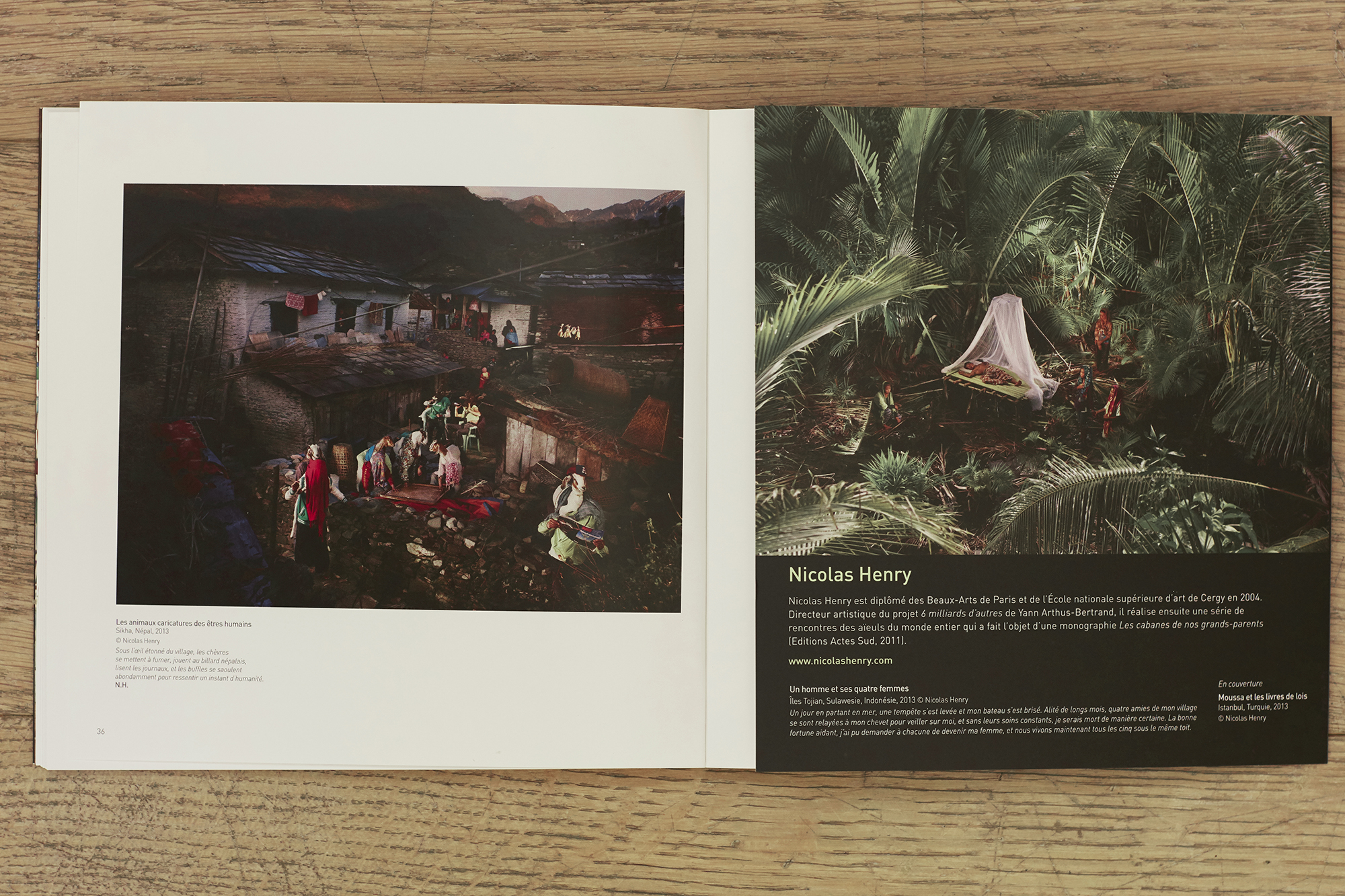TRAIT D'UNION
« The future belongs to those who believe in the beauty of their dreams ». Eleonor Roosevelt
Nicolas Henry and Floriane de Lassée, young plastic artists and photographers brought from their long travels from Africa to the Pacific through Latin America, colourful, blazing, poetic, oneiric, sensitive pictures, as many point of views about men, women and children met on the other side of the globe. It is a question of cross-look of two photographers both in love with life (both on the scene and in life) who traveled the world together in 2012 and 2013, the same continents but with their own perception, rare occasion of a dialogue between two perceptions of the world.
With Nicolas Henry, deep down storyteller and writer, each photographs tells a story that one about a community which has dreams, hopes and also concerns and sometimes quiet. The artist immerses himself in the local population in order to create with them a little ephemeral theater from recovered material and daily items, reflection of this shown life. During a day, this little stage is a fantasy world created from protagonist’s life story and tell an idea thanks to a visual narration. The preparation of this « ephemeral construction » takes time. Before a brand new shooting, the photographer becomes attached to the communities in order to create a certain confidence and stimulate an alchemy which is not always simple : language barriers, jealousy between each other, suspicion concerning the photographer … As many obstacles to overcome and to question about the artist role in our society. Nicolas Henry’s photographs are first of all testimony of this dialogue. Every where he comes over with his HasselBlad, he gives at first a moment to meet people, to spot the locations and then a second time to build photo sets. That is at the end of the second time that the shooting is taking place, often when the night is falling. Photography is a testimony of this fragile installation destined to disappear but captured for eternity.
Each photographs is a unique narrative composition supporting a message. Thus Nicolas Henry shows us urban violence, consumerism society, clash of civilisations, ages of life but also the chance to have a lover, a right to love which is not a prerogative for the all humanity. This is the message of the photograph calls « Maya et la déclaration d’amour aérienne » where Dan, the pilot declares his love to his betrothed during a little plane flight in front of all his family-in-law above the mountain, a very poetical picture. This photograph is an utopia because it testifies about a love union and not a forced marriage, Dan could choose his love, which is quite rare in Nepal, a society largely determinate by castes. On the contrary, in a photograph shot in Istanbul, a man belonging to the community of garbage collectors is dreaming about a beautiful woman looking at her reflection in a mirror. This is an inaccessible dream : because of his poverty, the man is living in ruins, he doesn’t have the possibility to have a lover and they can’t even have an eye contact. This is an apparition for the young man while on the background a veiled woman passes in front of a traditional house and reminds the weight of legacy. This photograph, as a real social panorama, is framed with fabrics like Peter Beard’s work.
Each photograph of Nicolas Henry is often engaged in a political way. In this photograph with young Japanese artists girls, their costumes are made with garbage and packagings on which they glued pages of erotical revues, symbol of the pollution and the waste they condemn and the feeling to be consumer items for society. Those are strong messages but concerned without miserabilism, with a certain cheerfulness and derision. Models are smiling at us in their strange gear with which they look like scarecrows while young students are waving at us like during Halloween time. On the back ground, a multicoloured street of Tokyo and a night blue sky strip for a « baroque » photograph well-composed. Likewise, in a photograph shot in Hong Kong, students pose on the roof of their art school. Nicolas chose this staging which is questioning about the place of individuals in the middle of a very abondant generation. Only two students are looking up to the sky, to their future while the other are sadly staring the same point, wearing garlands made of paper representing characters reproduced to infinity. The photograph takes the composition of a pagoda, a traditional shape which contrats with the big buildings with geometrical frontages emerging on the back-ground. The artist is worried about this unique child generation, lonely to face their future where they’re scared to lose the advantages acquired by the elders. Nicolas Henry’s photographs are well-built compositions where every detail has to be noticed in order to be a part of the picture and see the skilled political message in it.
Some photographs represent heavy emotional experience as this picture depicting young prostitutes jailed in a detention camp in La Paz (Bolivia) where they’re learned hygiene and daily gesture again with the hope to get out some day. This prison atmosphere is noticeable with outstretch hands between bars but hope and dreams come up to this terrible everyday life. Like Arcimboldo, the young girls write with their own body the word « Libertad » while the words « Love » and « Peace » are associated to « Violence » or « Disco » made with fabrics. Nicolas Henry is particularly interested in those fragiles marginal populations living in an agressive urban world, without family, without solidarity …
In Nicolas Henry’s photographs shot when the night is falling down and where characters are gripped in spectacular urban or rustic settings, a play with light and shadow which remind his first job as light designer for the theater. At sunset colours are extremely rich : from deep blue to mauve and dark orange of the last sun rays. The artist is playing with light and nature in order to dramatise his photographs, create a dramaturgy with a very complexe technique and process. This twilight oneiric universe is really present in « Le dortoir de Wumu » in Yuman (China). A big sister is reading a story to her little brother while pupils are trapped in cases made from desks, a composition which is a reminder of the famous « sense of space » series shit by the Goa Brothers. This photograph proposes a certain complexity between the two children in the foreground who improve their knowledges, free in the nature and the children in the back-ground who are trapped in boxes with any access to education. This composed scene where every item is real was be created without « addition of reality ». The picture shows a strange moon light almost surrealist, framed with mountain’s shadows and low clouds, a magical universe expressing a kind of melancholia.
Each picture is a new poetry. Nature offers enchanting settings that the plastic artist and photographer knows how to catch it for his compositions. Some photographs are paying tribute to the beauty of nature as that one depicting a young Japanese woman, Yukari, a former model in Tokyo who left the city in order to take back the artisanal paper work. Sat in front of a screen, she’s dreaming in front of a light ball which is maybe announcing love. A surfer passes by chance and looks at her under a blooming sakura which proposes a picture with a great plenitude and a timeless brightness. As for the luxuriance of nature, we can see it in the photograph shot in Sulawesi (Indonesian island) : a man is taking some rest surrounded by his four wives in a deep green vegetation, as a reminder of extraordinary landscapes of this archipels inhabited by « sea nomads ». The picture speaks about the the beautiful nature to be preserved but also about the complex human relationship (this man was sick and was treated by four women he decided to marry after).
One of the most impressive picture without a doubt is the one entitled « Moussa et les livres de lois ». It was exhibited in the museum in a wide size (71 in. x 94 in.) for an impressive face to face with the spectators. The protagonist is a Kurd from Istanbul lying in a « bed » made with law registers and seems to be so small in the middle of all those laws books, a world made with demanding rules making a whirlwind. The photograph makes out with its well-designed and graphical universe where books, ceramic tiles and interlacing on the banister reply to each other in a geometrical game almost abstract. This composition refers to Georges Rousse’s work who paints geometrical shapes in abandoned settings, the one of Andy Goldsworthy and his most inspiration is Anish Kapoor. Nicolas plans to develop a series in the way of this photograph using the theme of humans and items invasion.
Those photographs show Nicolas Henry as an art photographer and not a photo-reporter. His meticulous photographs always in quest of technical perfection are not made in the rush ; his work takes a certain distance with the actual news, even if each picture holds a message about « fragment of life ». Moreover every photographs has an original frame made by the artist himself from recovered materials which gives to each picture a unique style.
Floriane de Lassée, also a plastic artist and photographer, presents a series called « How much can you carry ? ». When Floriane de Lassée join Nicolas Henry in his first travel in Africa in 2012. She found herself in some deserted places in Ethiopia without the urban vibes, neon lights nor big buildings that use to be inspired by. Attentive to her discovery and far away of her regular inspiration sources, she had the idea to shoot the local populations holding on the head chosen items that seem important forlife. She posted her first pictures on Facebook and met a surprising success feedback so she decided to create a series.
In « How much can you carry ? » the photographer is interested in humans and the weight of life they hold as Atlas holding the Earth on his shoulders. The burden, heavy o light, cumbersome or compact, composed with usual goods found in the villages, is always surprising and the balance is often risky. Each « model » who lose its anonymity during a shooting, poses in front of an old and worn tarpaulin. This thick tarpaulin is an intensive background which enable to emphasise each personality : focused, intimidated, cheerful or proud. Willingly the tarpaulin does not recover all the back and let appearing for exemple a wall in cob. Sometimes the tarpaulin is replaced with a rock or a wall of stone as in the pyramid of little girls in Nepal where the frailest holds in her shoulders her three oldest, the first managing to grab the basket with her ball. A shrewd eye could see a four stages « DIY » swing holding the four children. All this unusual photographs are realised without a trick. However, often a string is used in order to support the pilings hold on the head of the protagonists ; as those little girls in Bolivia holding huge colourful harmony, reminding the first desire of the artist to be a painter.
If Floriane’s portraits remind us the weight of life and traditions, they always pleased us with their off-the-wall vision, never deteriorating but full of humour as this little Ethiopian girl, Aru, who is holding bundle of sticks topped with a goat. And what about the young girls with balls, fisher (wo)man in a tiny brazilian village and masseur during her free time whom the athletic look remind her dream to become a soccer champion ! Floriane is touched by her models and evokes with an amused smile this man who worn for this special occasion his most beautiful pink and sparkly jacket and his « smile » tee-shirt for a childish approach. Sometimes, some portraits are questioning about the unusual facts of our world as this man from Hamer’ tribe in Ethiopia who squeezes between his legs a kalashnikov and put on his head the packaging of a micro-waves, even though the village is connected to electricity only two hours per day.
Floriane’s photographs evoke by some aspects the zany side of life, funny and ridiculous in the same time. As for her personal colourful and sensual universe, it could get close to the Chinese artist Liu Bolin’s work and his famous « Hiding in the city » series even if most of Floriane’s portraits are depicting people living in remote village. As shown with this beautiful portrait of a young girl from Toraja, located in Sulawesi (Indonesia) who holds on top of her head buffalo’s horns, which is a sacred animal for this tribe. The reality is that horns’s pillars are fixed along the houses, sign of chance and ancestors’s respect. Floriane just needed to stretch a big deep night blue tarpaulin to give the illusion the girl is holding the horns. This photographs are printed on wood. This medium, a plank that Floriane sands herself, gives a good « matte look » to these portraits that could be touched and where the knot of the wood and the tarpaulin’s imperfections blend each other, giving to each picture a real strong plastic presence.
Nicolas Henry and Floriane de Lassée’s photographs are like opened wide widows on the world, they offer to us, immobile travellers, the occasion to discover the world. All of those photographs take us back far away from our everyday life but question us about the weight of life, the cultural differences, the delicateness of our planet where the possibility to love is not always a right, but where humans are keeping deep inside an essential need to dream. Mirrors of social relationships, they’ve got a symbolic ans humanist impact. They are like « hyphen » which bound us to the communities all over the globe.
Emmanuelle Lebail, director of Avelines Museum, Saint-Cloud
INTERVIEW BETWEEN DAMIEN BACHELOT, ART COLLECTOR, FLORIANE DE LASSÉE AND NICOLAS HENRY ON THE OCCASION OF THE SOLO SHOW AT AVELINES MUSEUM, SAINT CLOUD (FRANCE) . January 2014
Floriane de Lassée : Damien, with your wife, you’ve got one of the biggest photographs’s collection in France with more than 400 high quality pieces. Nicéphore Niece Museum (Châlon sur Saône) will exhibit a part of your collection, eighty photographs has been chosen by François Cheval, the exhibition entitled « d’une photographie sous tension » would be open until May, 18th, 2014. I take the liberty to quote François Cheval : « the power of Florence and Damien Bachelot’s collection, even its brutality, goes hand in hand with a clairvoyance for a « human condition » painting. Empathy has kept in their mind bright and intense colour ».
Damien Bachelot : First of all, I’d like to say that we are impulsive collectors, in a subjective way, we are in love with all the pieces that we have patiently chosen. I’ll never say that my subjective look is a reference but there is a major « human » interest in our collection, « human » is really emphasised. And a « tension » as François Cheval said …
FDL : From the day we met to today, you bought pieces to each of us and advices us at several occasions. Can you tell us why did you support our work ?
DB : I met Floriance while an exhibition devoted to her work. Those photographs close to abstraction because there were up-side-down express a big strength. From « Ciels de Seine » series , I bought « Le Pont de la Concorde ». Even if this piece wasn’t what we have the habit tu buy, we really had a crush for it. I met Nicolas in the same time.
Nicolas Henry : At this time, we were preparing our four-months travel to Africa and you bought one of my piece without telling me which one you would chose … This is almost a year later that you made your decision about an unusual and minimal portrait of a Namibian wearing a red costume and floating in a salt manufacturing. An image far away from my regular work but which had a lot of success.
DB : I’m naturally more attracted by Floriane’s work : we can « read » the piece quicker, her work is less narrative, less lyrical, less noisy than Nicolas’s. But this is not a question of good or bad, this is a personal feeling. In a way, Nicolas’s work could be an interesting language to the general public. What I really love in his work is the human project below. There is a social dimension : it confonds the trace let by the protagonists in the visited town with the exhibition’s spectators. To stride across the world looking for others, seems to be brave and a human attitude to me.
FDL : As for me, when I met Nicolas, I roamed the world’s megalopolis for years for my project « Inside Views ». From one day to the next, while tourning Africa with Nicolas, I was standing in tiny and dusty villages in Ethiopia, it was totally confusing ! I had no artistical point of reference ! But I was looking at people bringing their huge parcels along the roads that I had the idea of « How much can you carry ? » series.
NH : This discovery wasn’t entirely new. In your « Inside Views » series, this is the human being who gives its dimension to the city.
DB : This meeting undertook a sliding towards each other. In an equal way. This is a strength. You Nicolas and you Floriane, you’re trying unalike series and writings. And this endangerment gives to your new works, ideas. Like the beautiful Braque’s exhibition where we discover a multitude of periods and writings.
FDL : Finally to get closer and closer each other, is there a risk to be confused ?
DB : I don’t think so. To me, Floriane you are a « traditional » photographer, you work for years with dark chamber, went to graphic design and photography school. Nicolas uses this medium as a plastic artist. He comes through theater, using his knowledges about plastic installation, light and staging. This is a kind of performance, this is more than just photography. By the way, his huge plastic installation in « Les Rencontres d’Arles » enabled to contemplate his work outside the photography.
NH : During « Les Rencontres d’Arles », I proposed two pieces realised with four pianos and recovered wood left in the exhibition’s warehouse. A « church-synagogue-mosque-stupa » was facing an explosion of pianos turning it into an air war haunted by characters with broken face.
DB : Following the look of two artists working together on the same places is really interesting for the spectator because he’s git the point of view of each other. That’s also a point of view that I adopted as a collector. For exemple bringing face to face two very talented photographs : Saul Leiter and Bruce Davidson who worked in the same places, the same streets in New-York from the 60s to the 70s. Leiter with his coloured and pictural game, sometimes close from Nicolas de Staël’s work and Bruce Davidson « street photographer » with a social back-and-white phtography.
FDL : There is an other aspect really important in our meeting, this is the complementary of our skills. We help each other on each shooting.
NH : We’re sharing a huge photo studio. That enables to obtain this very pictural aspect in our pictures. Sometime it could even question the spectator who is not able to tell if the pictures are real or fake, created on a computer. However all the settings and lights are built during the shooting and then the finalisation is made with a computer.
DB : « Photoshop » doesn’t matter. At the beginning of photography, during the XIXe century, Gustave Le Gray composed his sea photographs using different pictures. From its beginning, the photography was not recognise as an art. You’re the first generation using a computer, it takes time to people to consider a new medium as an art. Photography brings a real split with the past. Until the XXe century, the artist was someone with a hight technical mastery. He had to be a good craftsperson before hoping to become an artist. Today this is not necessary anymore because everyone could take a « worldwide » picture. We almost unknown who took Che Guevara portrait, American soldiers sticking the flag or the one depicting workers building the Empire State Building in New-York … Then, there is talent : why pictures shot by Gilles Caron stand out from the one of the six other photographers present in the same place in the same time ? Not to mention Cartier-Bresson whose the look created master-pieces during all his life. With the time maybe you’ll reach the talent of these masters. There is a true quality in your work and that’s where the unique aspect is. Among the young, we can see almost 90% of ideas copied somewhere. My wife and I are always interested in when we discover a real artistic identity.




